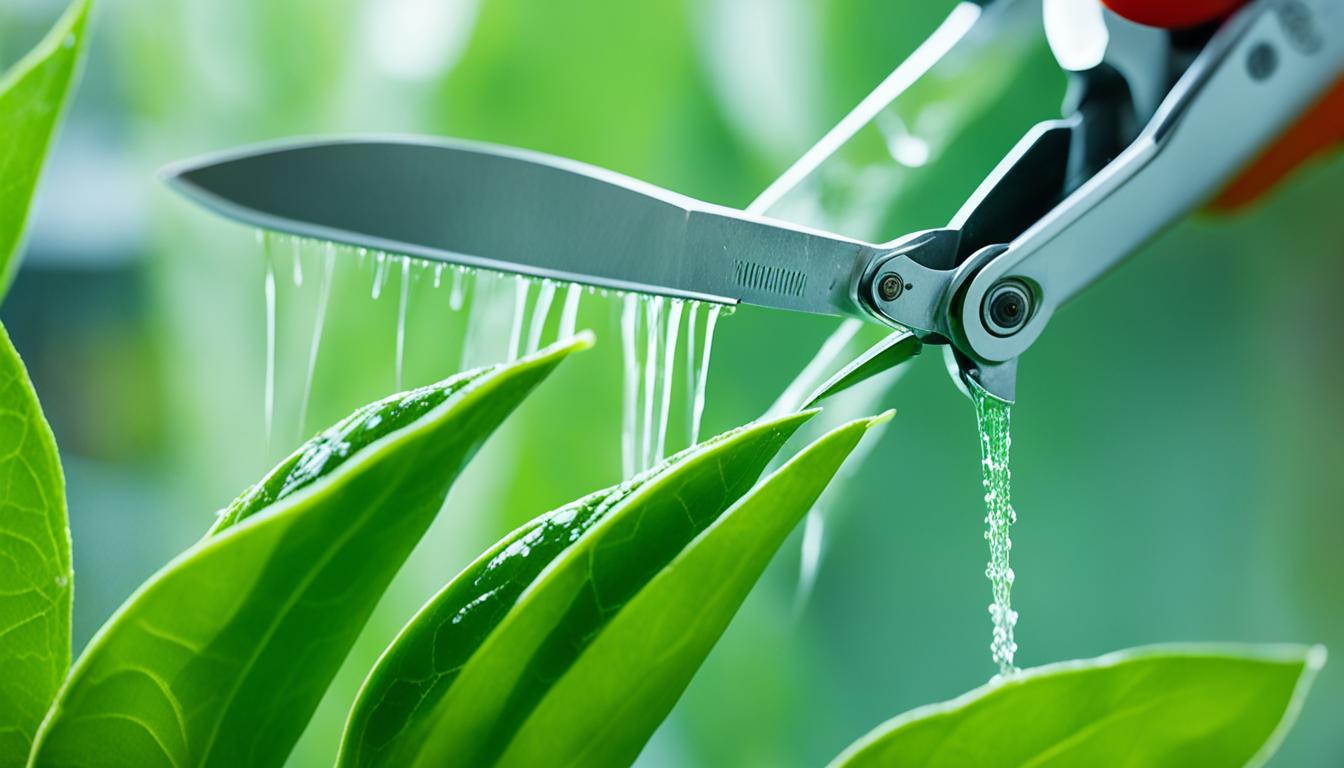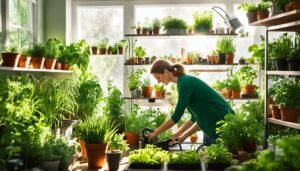Did you know that the secret to lush, vibrant houseplants might just be in the snip of your shears and the swipe of your cloth? Are you ready to unlock the full potential of your indoor garden with some expert pruning and cleaning tips?
Indoor plant care involves various practices, including pruning and cleaning, that are crucial for maintaining the health and vitality of houseplants. Proper pruning techniques help control the size and shape of plants, promote new growth, and remove dead or damaged foliage. Cleaning houseplants removes dust and debris, improving their overall appearance and allowing them to better absorb light. By mastering these cutting-edge care techniques, you can ensure the optimal growth and well-being of your indoor plants.
Key Takeaways:
- Pruning and cleaning are essential for maintaining the health and vitality of indoor plants.
- Proper pruning techniques control plant size, shape, and promote new growth.
- Cleaning houseplants removes dust and debris, improving their appearance and light absorption.
- Mastering pruning and cleaning techniques will lead to lush and vibrant indoor plants.
- Stay tuned for expert tips and guidelines on the art of pruning and keeping your indoor plants clean.
Introduction
Welcome to the world of indoor plant care! In this section, we will explore the essential techniques for maintaining healthy houseplants. Proper care is crucial to ensure the vitality and longevity of your indoor greenery. Two key aspects of indoor plant care that we will focus on are pruning and cleaning. These techniques play a vital role in promoting the overall health and well-being of your plants.
Pruning involves selectively removing parts of a plant, such as branches and leaves, to control its size and shape. By doing so, you can stimulate new growth and remove any dead or damaged foliage. Cleaning, on the other hand, is the process of removing dust and debris from the leaves of your indoor plants. Dust can hinder their ability to absorb light and photosynthesize effectively.
Proper care not only helps your plants thrive, but it also offers a range of benefits. For instance:
- Improved air quality: Indoor plants act as natural air purifiers, and proper care ensures they perform this function optimally.
- Enhanced aesthetics: Clean and well-pruned plants significantly enhance the overall appearance of your living space.
- Insect prevention: Regular cleaning can help prevent common pests from infesting your indoor plants.
- Faster growth: Pruning allows you to direct a plant’s energy toward healthier foliage, promoting robust growth.
By implementing these techniques, you can enjoy healthier, more vibrant, and long-lasting indoor plants. Let’s dive into the art of pruning and the importance of cleaning to uncover the secrets to successful indoor plant care.
The Art of Pruning
Pruning is an art form that involves selectively removing parts of a plant to manage its size and shape, promote new growth, and direct energy towards healthier foliage. This section will delve into the purpose of pruning and the benefits it brings to indoor plants. We will also discuss various pruning techniques and how they promote growth and vigour.
Pruning serves several important purposes in indoor plant care. Firstly, it allows you to control the size and shape of your plants, ensuring they fit harmoniously within their designated space. This is particularly useful for plants that tend to grow rapidly or become leggy over time.
By removing excess growth, you can maintain a compact and aesthetically pleasing plant. In addition to managing size, pruning also plays a crucial role in promoting new growth. Cutting back branches or stems stimulates the plant to produce new shoots, resulting in a denser and fuller appearance.
Another benefit of pruning is the removal of dead or damaged foliage. Any leaves or branches that show signs of disease or decay should be promptly pruned to prevent the spread of infection and enhance the overall health of the plant.
Moreover, pruning techniques such as pinching, tip pruning, and thinning can help direct the plant’s energy towards healthier foliage. Pinching involves using your fingers or pruning shears to remove the tips of new growth, encouraging branching and increasing the density of the plant.
Tip pruning, on the other hand, focuses on removing the uppermost bud or growth tip to redirect the plant’s energy to lateral branches and encourage bushier growth. Thinning, as the name suggests, involves selectively removing some branches or stems to improve airflow and reduce overcrowding, improving the plant’s overall health.
By mastering the art of pruning, you can ensure that your indoor plants not only look their best but also thrive in a conducive environment. The techniques you learn and apply will not only promote growth and vigour but also contribute to the overall well-being of your green companions.
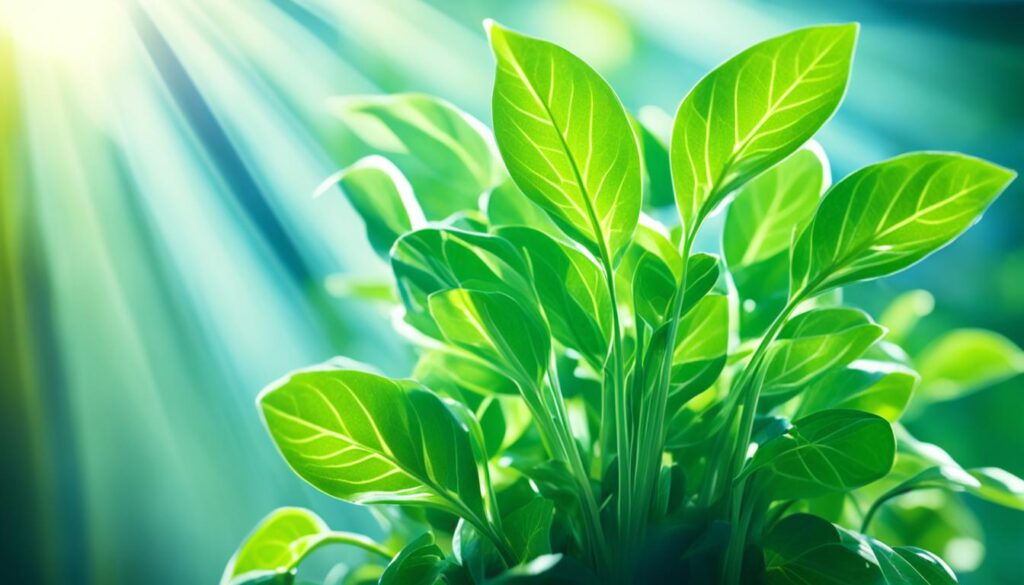
Benefits of Pruning
Pruning offers a multitude of benefits for indoor plants:
- Promotes new growth: Pruning stimulates the plant to produce new shoots, resulting in a denser and fuller appearance.
- Controls size and shape: By selectively removing parts of the plant, pruning allows you to maintain a desired size and shape, ensuring your plants fit harmoniously within their environment.
- Improves plant health: Removing dead or damaged foliage prevents the spread of disease and promotes overall plant health.
- Directs energy towards healthier foliage: Pruning techniques such as pinching, tip pruning, and thinning help redirect the plant’s energy towards healthier and more vibrant foliage.
- Enhances aesthetic appeal: Pruned plants exhibit a cleaner and more polished appearance, enhancing the overall aesthetic appeal of your indoor space.
Pruning Techniques
There are several pruning techniques you can employ to achieve the desired results:
- Pinching: Using your fingers or pruning shears, pinch off the tips of new growth to encourage branching and increase plant density.
- Tip pruning: Remove the uppermost bud or growth tip to redirect the plant’s energy to lateral branches, promoting bushier growth.
- Thinning: Selectively remove branches or stems to improve airflow and reduce overcrowding, leading to better overall plant health.
- Heading back: Cut branches or stems back to a lateral bud or side shoot to encourage branching and create a more compact plant form.
- Crown reduction: Reduce the height of the plant’s main stem or central leader to control growth and prevent top-heavy plants.
| Pruning Technique | Benefits |
|---|---|
| Pinching | Encourages branching and increases plant density |
| Tip pruning | Redirects energy to lateral branches, promoting bushier growth |
| Thinning | Improves airflow and reduces overcrowding for better plant health |
| Heading back | Encourages branching and creates a more compact plant form |
| Crown reduction | Controls growth and prevents top-heavy plants |
Tools of the Trade
When it comes to pruning your indoor plants, having the right tools is essential. To ensure precise and clean cuts, you’ll need a few key pruning tools in your arsenal. Here are the essential tools for proper pruning:
- Pruning Shears: Pruning shears, also known as hand pruners or secateurs, are a must-have tool for any indoor gardener. These handheld scissors-like tools provide the leverage needed to cut through stems and branches with ease, making them perfect for precision pruning.
- Scissors: While pruning shears are ideal for larger cuts, scissors are indispensable for intricate pruning tasks. Scissors allow you to carefully trim small leaves and delicate growth, giving you greater control over the shaping and grooming of your indoor plants.
- Saws: For larger and tougher branches, a pruning saw is the go-to tool. With a sturdy blade and a comfortable grip, a pruning saw enables you to tackle thicker growth and make clean cuts, promoting the overall health and growth of your plants.
Equipped with these essential pruning tools, you can confidently maintain the shape and health of your indoor plants. Remember to keep your tools clean and well-maintained to ensure their longevity and effectiveness.
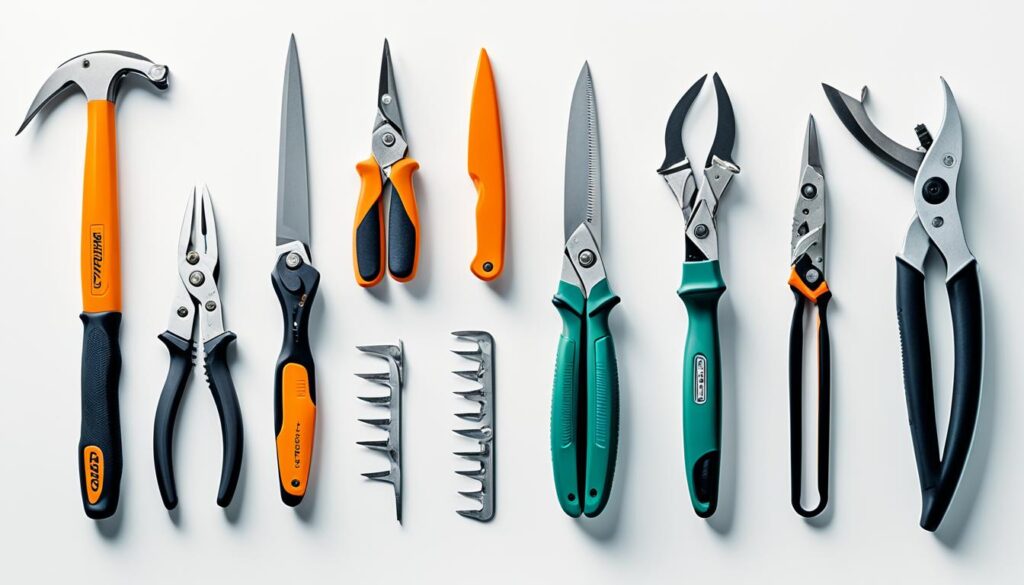
Pruning Practice
When and How to Prune Houseplants
Pruning houseplants is a critical practice that should be done at the appropriate time and using the correct techniques to ensure optimal plant health and growth. In this section, we will explore when and how to prune different types of houseplants, including flowering plants, foliage plants, and vining plants. We will also provide a pruning schedule and share tips and guidelines to help you achieve successful pruning practices.
When it comes to pruning houseplants, timing is key. Different plants have specific growth patterns and seasons, which determine the best time for pruning. For flowering plants, it is often best to prune after they have finished blooming. This allows you to remove any dead or faded flowers, promoting new growth and enhancing the overall appearance of the plant.
Foliage plants, on the other hand, can be pruned at any time of the year. However, it is advisable to prune them during their active growth period, which is typically in spring or early summer. Pruning during this time stimulates new growth and helps maintain the plant’s desired shape and size.
Vining plants, such as pothos or philodendrons, can benefit from regular pruning to prevent them from becoming too leggy or overwhelming the space they are in. Trimming back the long vines and encouraging branching can help these plants maintain a compact and bushy appearance.
To ensure successful pruning, it is important to follow some general guidelines. Make sure to use clean and sharp pruning tools to avoid damaging the plant. Start by removing any dead or diseased foliage first. Then, selectively prune branches or stems to shape the plant and promote growth. Be mindful of the plant’s natural growth habit and avoid over-pruning, as this can cause stress and hinder its overall health.
Remember to always consider the specific needs of each plant when pruning. Some plants may require more frequent pruning, while others only need minimal maintenance. It is always best to research the specific requirements of your houseplants to ensure they receive the appropriate care.
| Type of Houseplant | Best Time to Prune | Pruning Technique |
|---|---|---|
| Flowering Plants | After blooming | Remove faded flowers, prune to desired shape |
| Foliage Plants | During active growth (spring or early summer) | Prune to maintain shape and promote new growth |
| Vining Plants | As needed | Trim long vines, encourage branching |
Keeping It Clean
Cleaning the leaves of indoor plants is an important aspect of plant care. Dust and debris can accumulate on leaves, hindering their ability to photosynthesize and absorb light. Proper leaf care ensures that your plants can thrive and maintain their optimal health.
Regular cleaning of indoor plant leaves offers several benefits:
- Improved Appearance: Cleaning removes dust and dirt, giving your plants a fresh and vibrant look.
- Enhanced Photosynthesis: When leaves are clean, they can absorb light more effectively, leading to better photosynthesis and growth.
- Pest Prevention: Dust and debris can attract pests, including spider mites and mealybugs. Regular cleaning helps reduce the likelihood of infestations.
There are various methods and techniques to clean your indoor plant leaves:
- Hand Cleaning: Gently wipe each leaf with a soft, damp cloth to remove dust and dirt.
- Shower Rinse: Take your plants to the bathroom and give them a gentle shower under lukewarm water. Be sure to avoid strong water pressure, which can damage delicate leaves.
- Misting: Use a spray bottle filled with water to mist the leaves, then wipe them clean with a cloth. This method is suitable for smaller plants or those with delicate foliage.
Remember to clean both upper and lower leaf surfaces to ensure thorough leaf care. For plants with fuzzy or hairy leaves, avoid misting as it can lead to fungal infections.
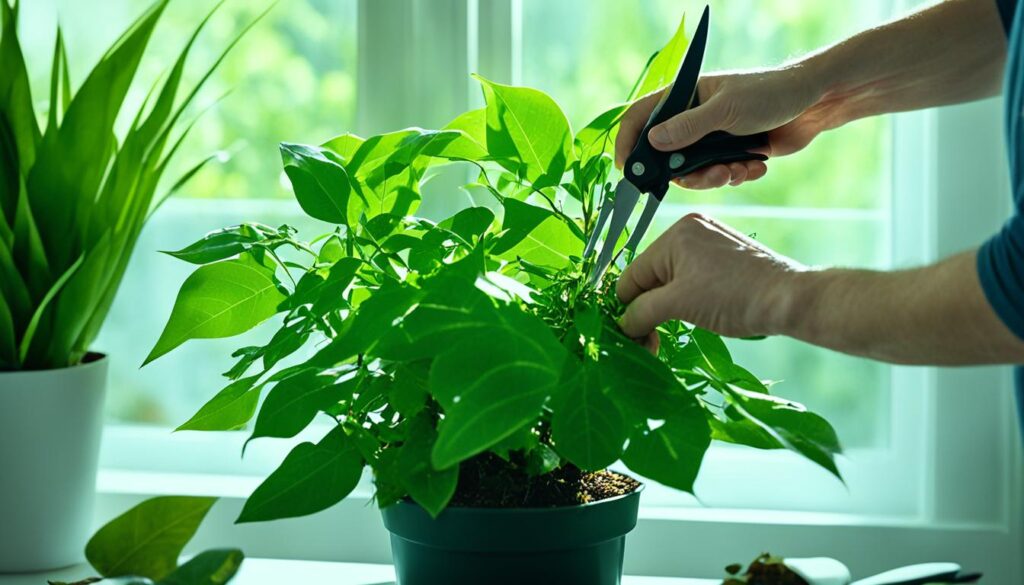
Pest Prevention Through Cleaning
Regular cleaning practices are essential for preventing pest infestations in indoor plants. Dust, debris, and stagnant water can create favorable conditions for pests to thrive. By incorporating cleaning into your plant care routine, you can maintain a pest-free environment and promote the overall health and vitality of your plants.
Cleaning as a Pest Control Method
Cleaning not only keeps your indoor plants looking their best but also helps deter pests. Here’s how:
- Remove dust and debris: Dust on leaves can interfere with photosynthesis and make plants more susceptible to pests. Gently wipe down the leaves with a soft, damp cloth to remove any accumulated dust and debris.
- Avoid overwatering: Excess moisture can attract pests, such as fungus gnats and root rot pathogens. Proper watering practices, such as allowing the soil to dry slightly between waterings and providing adequate drainage, can help prevent these issues.
- Sanitize plant containers: Regularly clean and disinfect plant containers to eliminate any lingering pests or diseases. Use a solution of one part bleach to nine parts water, and thoroughly rinse the containers before reusing them.
- Inspect new plants: Before bringing new plants into your indoor garden, carefully inspect them for any signs of pests or diseases. Quarantine new plants for a few weeks to monitor their health before introducing them to your existing plant collection.
In addition to regular cleaning practices, you can also incorporate homemade sprays and natural pest control methods into your routine to further prevent pest infestations. These methods are not only effective but also environmentally friendly, minimizing the use of harsh chemicals and promoting a healthier indoor environment for both you and your plants.
Refresh and Renew
Repotting and Soil Maintenance
In addition to pruning and cleaning, maintaining the overall health of indoor plants involves repotting and soil maintenance. Repotting is an essential task that allows plants to grow and thrive in fresh, nutrient-rich soil. Over time, the soil in your houseplants’ containers can become depleted of nutrients and compacted, hindering proper root growth and drainage. By repotting your plants, you provide them with a fresh start and renewed vitality.
When repotting houseplants, it is crucial to choose the right soil that meets their specific needs. Different types of plants have varying soil requirements, such as well-draining soil for succulents or moisture-retentive soil for tropical plants. Understanding these needs and selecting the appropriate soil will ensure optimal growth and prevent issues like root rot.
Proper drainage is another vital aspect of soil maintenance. Good drainage allows excess water to escape from the root zone, preventing waterlogging and associated problems. Using pots with drainage holes, adding a layer of rocks or pottery shards at the bottom of the pot, or incorporating perlite or vermiculite into the soil mixture can all improve drainage.
Troubleshooting common issues related to soil maintenance is essential for the long-term health and well-being of your indoor plants. Some common problems include overwatering, underwatering, nutrient deficiencies, and pest infestations. By closely monitoring your plants and addressing any issues promptly, you can ensure their continued growth and vitality.
Common Soil Issues and Troubleshooting
| Issue | Troubleshooting |
|---|---|
| Overwatering | – Adjust watering frequency and only water when the top inch of soil is dry – Improve drainage by repotting in well-draining soil or adding perlite – Ensure pots have drainage holes to allow excess water to escape |
| Underwatering | – Increase watering frequency when the top inch of soil is dry – Use your finger to check the moisture level in the soil – Consider using a self-watering pot or installing a water meter for more accurate watering |
| Nutrient deficiencies | – Use a balanced fertilizer or specific fertilizers designed for indoor plants – Follow the recommended dosage and frequency provided by the manufacturer – Consider using organic compost or plant food for long-term nutrient enrichment |
| Pest infestations | – Regularly inspect your plants for signs of pests – Use natural pest control methods, such as neem oil or insecticidal soap – Quarantine infested plants to prevent the spread of pests to other plants |
By following best practices for repotting and soil maintenance, you can ensure the health and vigor of your indoor plants. Regularly assess the condition of your plants’ soil, provide them with fresh soil as needed, and troubleshoot any issues that arise. With proper care and attention, your indoor plants will thrive and bring beauty to your space.
Conclusion
Mastering the techniques of pruning and cleaning is vital for the health and vitality of your indoor plants. By understanding the purpose and benefits of pruning, you can effectively control the size and shape of your plants, promote new growth, and remove any damaged or dead foliage. Additionally, cleaning the leaves of your indoor plants not only improves their appearance but also enhances their ability to absorb light and photosynthesize.
Remember, when pruning your houseplants, make sure to use the right pruning tools such as shears, scissors, and saws for precise and clean cuts. It’s also important to prune your plants at the appropriate time and follow the specific techniques for different types of plants. This will help ensure successful pruning practices and optimal results.
Incorporating regular cleaning practices into your plant care routine serves as a preventive measure against pest infestations. Dust and debris can attract pests, so be sure to clean the leaves using appropriate methods and techniques. Additionally, consider using natural pest control methods alongside your cleaning efforts for a holistic approach to pest prevention.
As you care for your indoor plants, don’t forget about repotting and soil maintenance. Repot your plants when needed, providing them with the proper soil needs and ensuring proper drainage. By addressing these key aspects of plant care along with pruning and cleaning, you will be equipped to nurture healthy, thriving indoor plants that bring beauty and greenery into your space.
For more valuable Expert Tips check out our comprehensive Houseplant Guide to Tips for Indoor Plant Care.
If you happen to be nearby, stop in at The Landscape Connection and say Hi. Michelle and I would love to meet you.
FAQ
What is the purpose of pruning houseplants?
Pruning involves selectively removing parts of a plant to manage its size and shape, promote new growth, and direct energy towards healthier foliage.
What are the benefits of pruning indoor plants?
Pruning promotes growth and vigor, controls the size and shape of plants, and removes dead or damaged foliage.
What tools do I need for pruning houseplants?
Essential tools for pruning include pruning shears, scissors, and saws.
When should I prune my houseplants?
The timing and techniques for pruning vary depending on the type of houseplant. It’s important to follow a pruning schedule and guidelines for each specific plant.
Why is it important to clean indoor plant leaves?
Cleaning removes dust and debris from leaves, allowing them to better absorb light and photosynthesize. It also improves the overall appearance of the plant.
How often should I clean my indoor plant leaves?
Cleaning should be done regularly, at least once a month or more frequently if there is a significant buildup of dust and debris.
How can cleaning prevent pest infestations in indoor plants?
Regular cleaning practices help control and prevent common plant pests by removing their eggs and reducing their breeding grounds.
What are some homemade sprays I can use for pest control?
Natural pest control methods include homemade sprays made from ingredients like neem oil, garlic, or vinegar.
How often should I repot my houseplants?
Houseplants typically need to be repotted every 1-2 years, depending on their growth and the size of their current container.
What are the common soil maintenance issues for indoor plants?
Common soil maintenance issues include overwatering, improper drainage, nutrient deficiencies, and pests. Troubleshooting these issues is important for the overall health of your plants.


